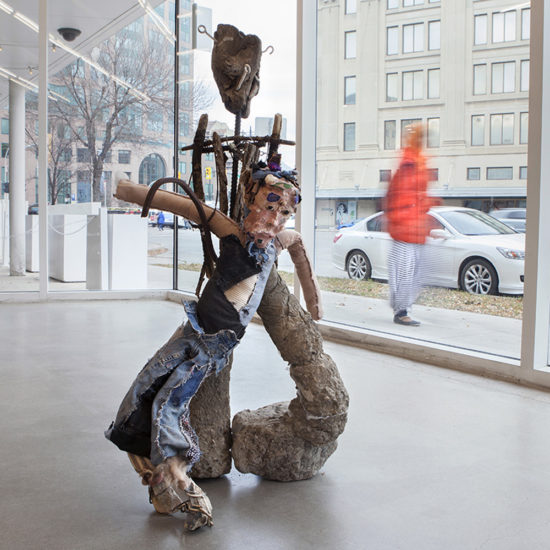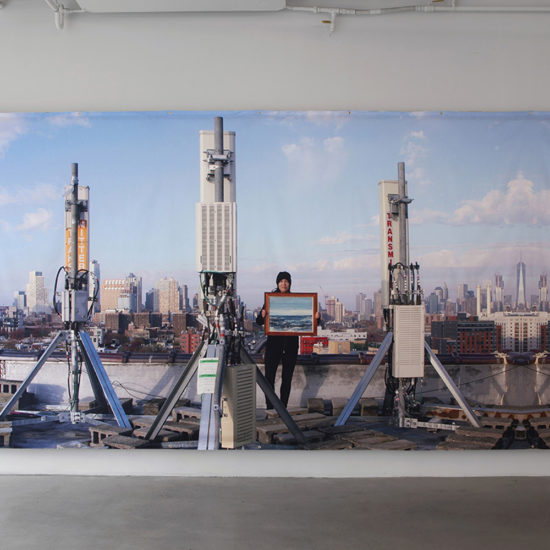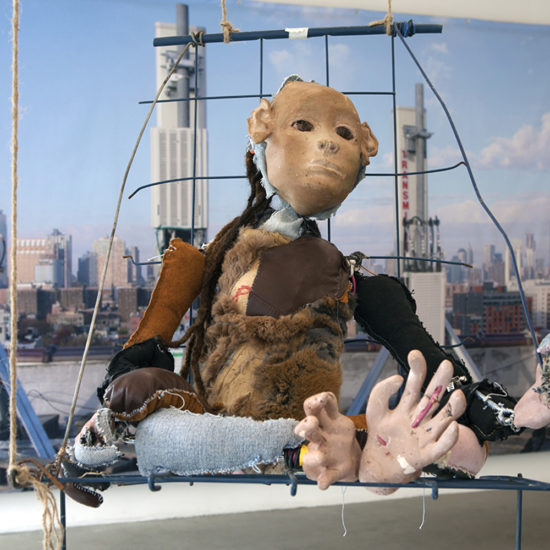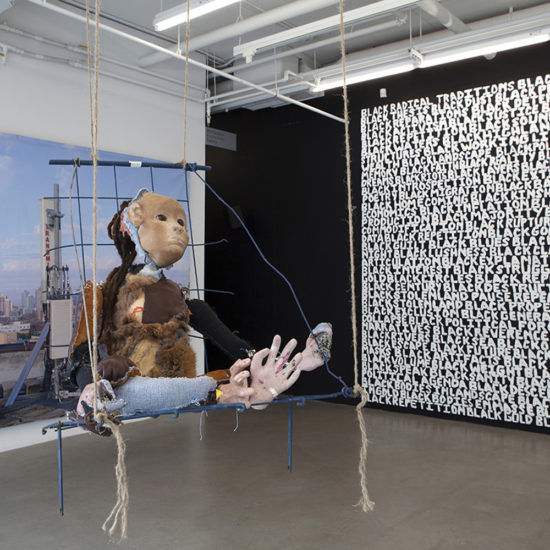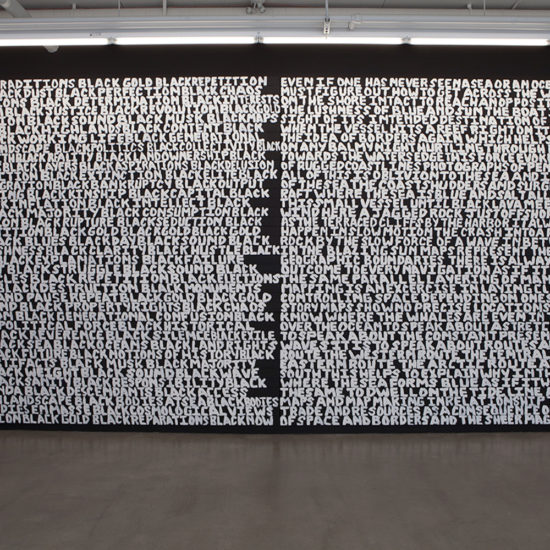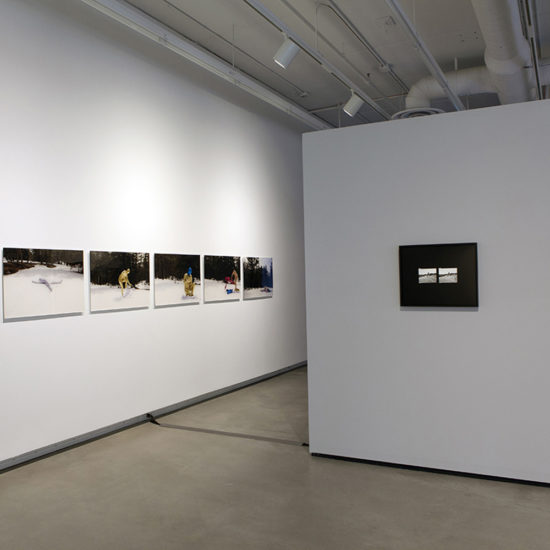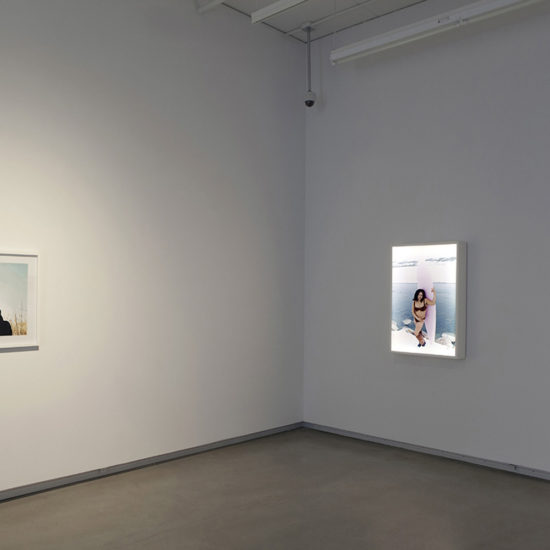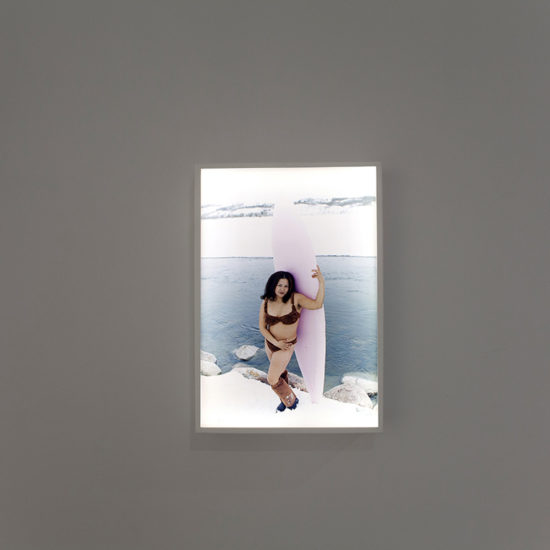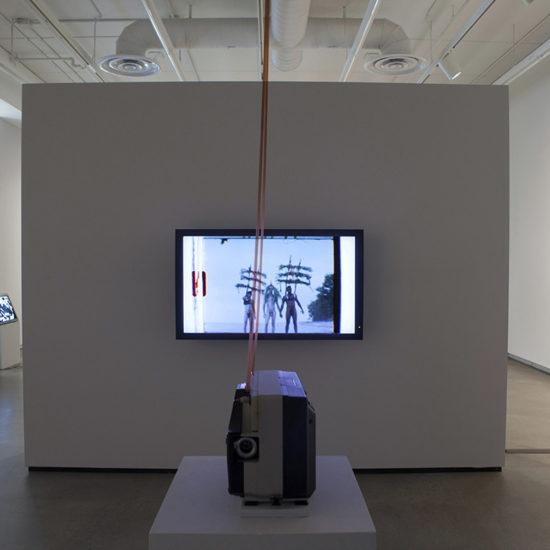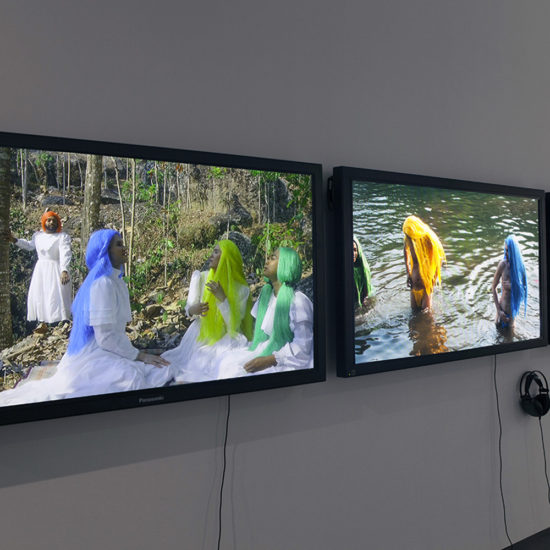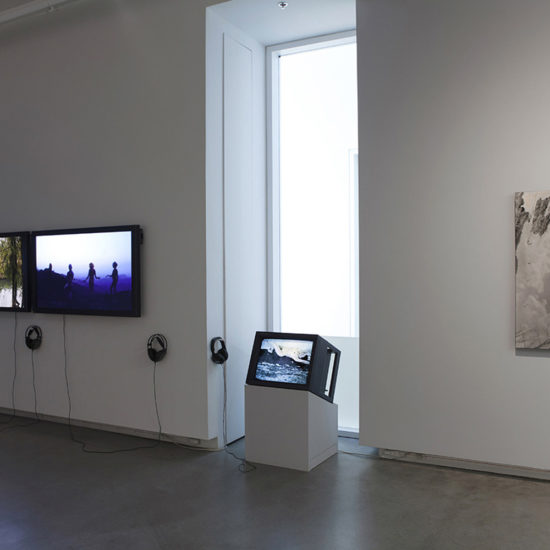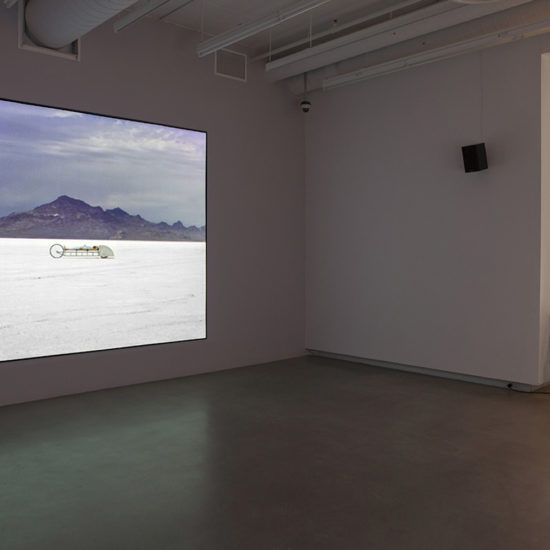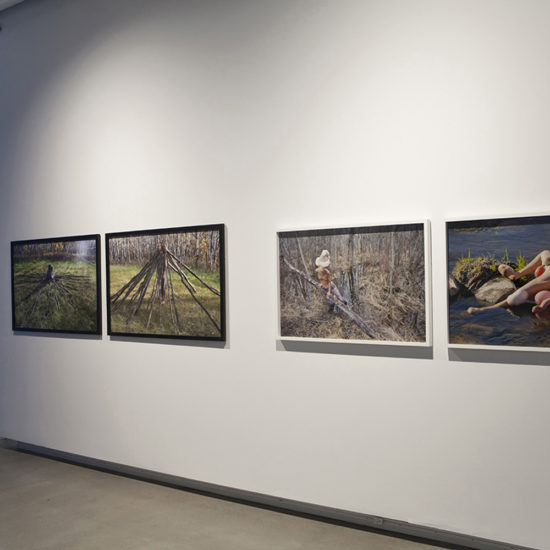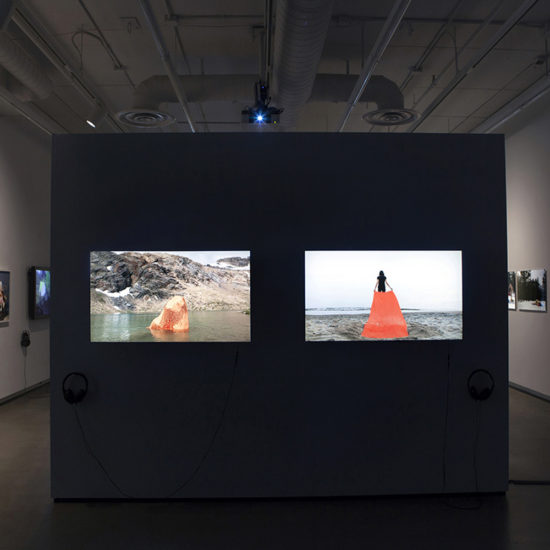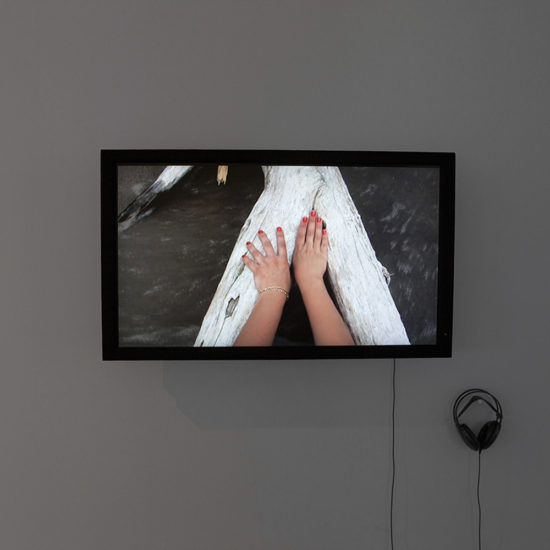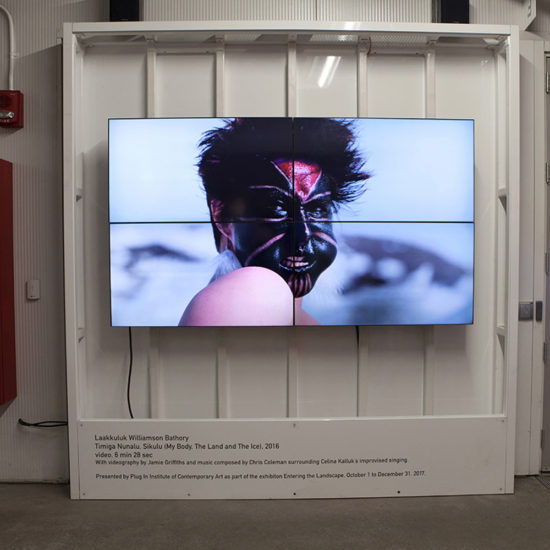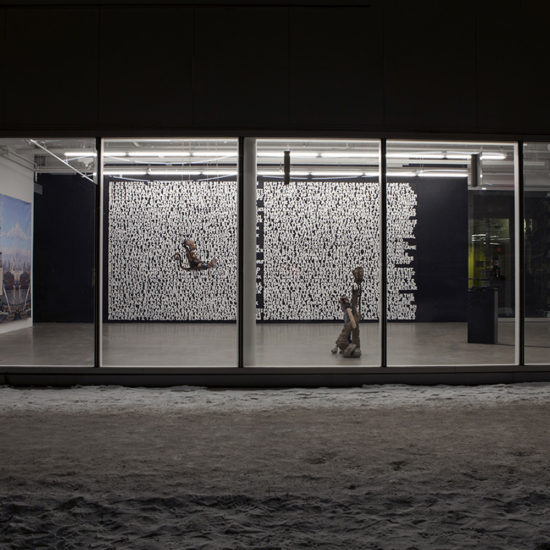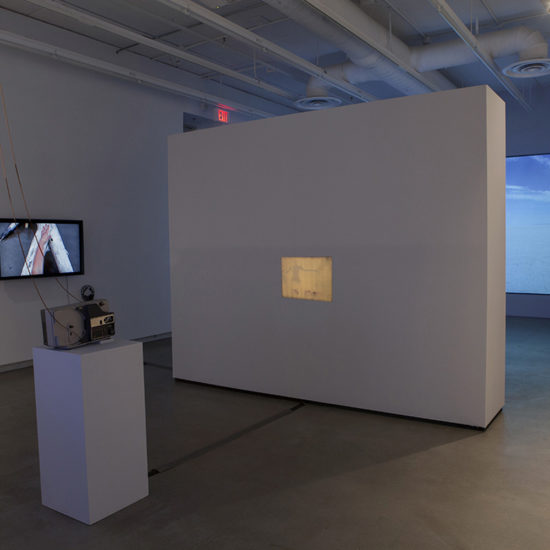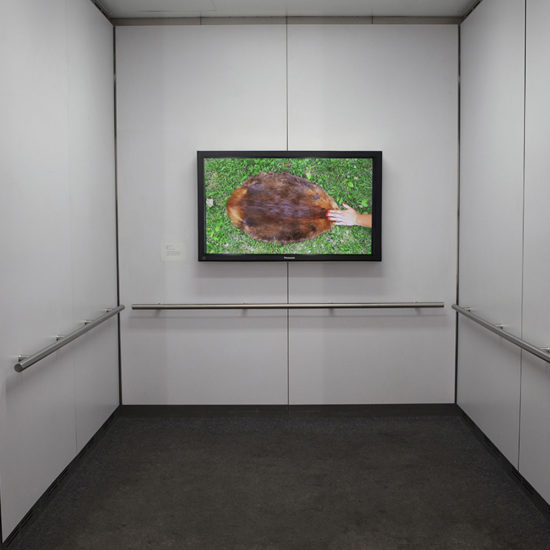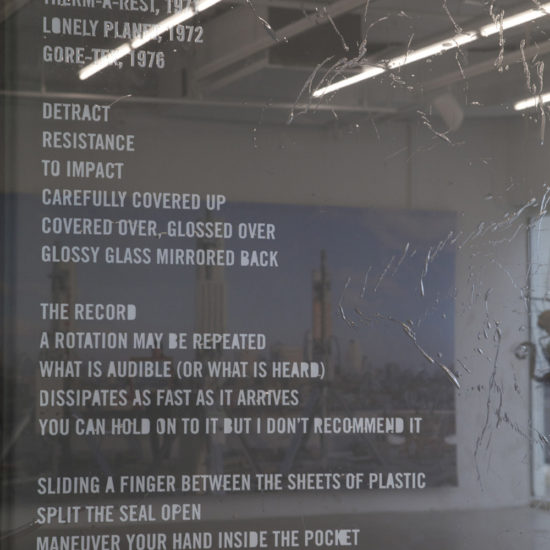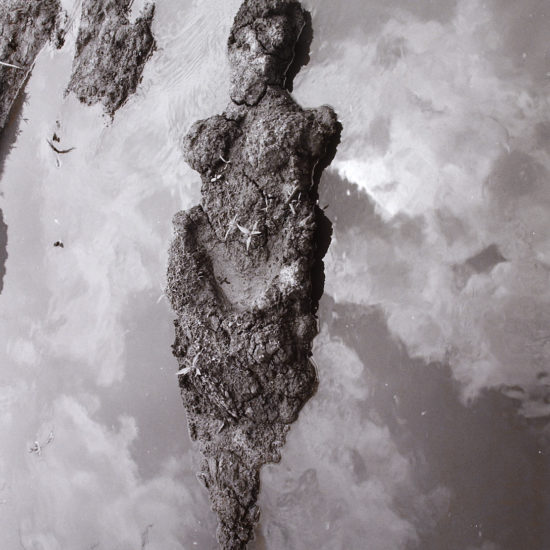Pia Arke (1958-2007 Greenland and Denmark) • Laakkuluk Williamson Bathory (Iqaluit) • Jaime Black (Winnipeg) • Lori Blondeau (Saskatoon) • A.K. Burns (New York) • The Ephemerals (Winnipeg) • Melissa General (Toronto) • Rebecca Horn (Berlin) • Katherine Hubbard (New York, USA) • Maria Hupfield (New York) • Simone Jones (Toronto) • Tau Lewis (Toronto) • Amy Malbeuf (Rich Lake Alberta) • Meryl McMaster (Ottawa) • Ana Mendieta (Cuba) • Natalie Purschwitz (Vancouver) • Dominique Rey (Winnipeg), • Jamie Ross (Montreal) • Xaviera Simmons (New York) • Ming Wong (Berlin) • Alize Zorlutuna (Toronto)
Entering the Landscape
October 1 to December 31, 2017
Entering the Landscape is a contemplative group exhibition featuring twenty-one artists from Canada, the USA, Denmark, and Berlin. Working in film and video, photography, sculpture, and performance these artists represent a breadth of politicized contemporary and iconic historical works that place the female or queer body in the landscape. Bringing together artworks that conceptually and aesthetically overlap, this exhibition identifies and considers a persistent motif in contemporary art. (full text and list of works below)
– Curated by Jenifer Papararo and Sarah Nesbitt
All public programming is free and open to the public. Everyone welcome!
[curatorial text]
BODY
Entering the Landscape contains a feminist narrative, focused on the female body, its representation and relation to the land. Through gendered and ecological lines, we group artworks by twenty-one artists in which body and land are represented together. The exhibition’s curatorial premise responds to what we define as a re-occurring motif in which artists place the female or queer body in the landscape. We reflect on why we are seeing this subject figure so prominently in contemporary artwork while also connecting it to historical works that takes us rolling back to the early seventies through to the nineties into our current decade. Appearing most often are the artists’ bodies placed within a generalized and dislocated geography. The artist, often portrayed alone, becomes a character and an actor performing within the landscape, moving through it, using it, becoming part of it, rubbing it or camouflaged by it. Within these works there seems to be a valorization of both body and land, but it is the inclusion of the body whether female or queer that establishes a critical and political framework.
The bodies presented within Entering the Landscape shape its subject, and is where this exhibition’s power lies. Within feminist discourse the female body has been its epicentre whether it is drawing a history of woman’s subjugation confined to sexuality and childbirth as a point of control, or inversely claiming and asserting the body as an authority. In Caliban and the Witch the Marxist historian and feminist activist, Slivia Federici defines the female body within economic terms that establishes “that the body has been for women in capitalist society what the factory has been for male waged workers: the primary ground of their exploitation and resistance.” The body for women becomes a pivotal and powerful source of identity as well as a prison that is bound to both sexuality and maternity. So the body is essential to feminism but also problematic when valorized as it can too easily teeter into a dominant narrative that characterizes femininity within a patriarchal construct – in Federici’s words “as a means of reproduction and accumulation of labour.”*
To escape this duality, the body can be placed, and within this exhibition, it is placed into the land – Entering the Landscape as the exhibition title describes. Within the landscape, the predetermined female, racialized or queer body can command, converse and control; it can parody as caricatures of femininity, or it can meld into the background, without being subsumed. It can stroke the land, climb on it, rip it to pieces, and ride it – all within a measured framework, tying the body to the land within a set of controlled parameters that differs from the conventions of the sublime in nature, which generate a distance between the body and the unfathomable terror and vastness of the earth. There is a relationship between body and land that is being established without overly manipulating the ground one walks on – without fashioning it into a spiral or stabbing hundreds of steel rods into the earth to summon lighting. Throughout the many works in this exhibition, the insertion of the body is deliberate and controlled but not necessarily designed to manipulate or master.
In establishing a curatorial premise that presents various images of diverse women or gender queer bodies in the landscape is to tread near gendered and racial stereotypes. The construct of mother earth comes to mind. As well, we are weary of romanticizing notions of indigenous customs. Through the work selected we intend to delicately dissect these over prescribed representations while sincerely asking why are we encountering an array of work that positions the female or feminized figure within the landscape at this moment? What does this overt insertion of the female body within the land signify?
Jenifer Papararo
*Silva Federici, Caliban and the Witch (Brooklyn, NY: Autonomedia, 2009) 16
LAND
Centering the female and queer body in the land places Entering the Landscape in conversation with a long and fraught history of representation that crisscross the visual, personal, social and political. Used as an apparatus of colonial imperialism, representation of the natural world and the presence or absence of specific bodies in that world has had dramatic consequences. In the Canadian context early depictions of landscape were central to initial settlement and later – with the usurpation of the by now infamous Group of Seven – for establishing a national identity that distinguished Canada from the British Empire.
The use of ‘landscape’ in the exhibition title is thus a consciously troubled one that understands these historic associations and a linguistic weightiness of immediate ties to European aesthetic traditions, stemming from its Middle Dutch etymology landscap. As an English verb, landscape becomes ‘landscaping’ or ‘to landscape’– implying manipulation of the natural or urban environment for a specific aesthetic outcome. Taken another way, the term makes a notable connotative shift. Instead of describing physical space, it becomes descriptive of “a sphere of activity” – as in ‘the political landscape’. And yet another way of thinking about landscape relates to embodied perspective – as signifying a specific vantage point within space where the range of vision, sonic or emotional experience becomes the point of reference.
It is this position of embodied perspective in relation to land or landscape, and the specificity that entails which we encounter and are invited into by each of the artists in Entering the Landscape. The influence of performance art in the sixties and seventies, and the democratization of the camera are obvious points of reference in many of the works and artists presented. A set of historic pieces ranging from the 1960’s to the 1990’s that function as touchstones for our thinking also highlight the wide range of strategies, concerns and references used by artists in the exhibition. Rebecca Horn uses fabric, wood and metal inUnicorn to extend the formal limitations of the body as it performs the simple gesture of walking for the video camera; in Ana Mendieta’s Isla, a photographic document is what remains of an earthwork, which composed the female body from the earth itself. Shaped in the form of an isla or island it becomes a direct reference to the embodied experience of exile or displacement; Pia Arke’s Arctic Hysteria places the artists nude body in a room with a large printed photograph of a generic ‘Arctic’ landscape, which she slowly destroys, ripping at piece by piece, while performing ‘hysterical’ gestures – rolling and flailing her limbs; and Lori Blondeau’s Lonely Surfer Squaw again places the artist’s body in front of the camera. Fur bikini clad, and clutching a surfboard, in parody, she looks directly into the lens. Like Arke, Blondeau’s appearance in the frame is a confrontation to stereotypical representations and expectations of the Indigenous, female body.
In equal measure to the bodies that inhabit them, the landscape is subject and material, which often holds multiple, sometimes overlapping roles in the presented works. The specificity of site is rarely essential to the immediate meaning, ceding to larger, psychosocial, political or aesthetic concerns. With performance art, including performance for the camera – a strategy used by many of the artists in Entering the Landscape – the immediacy and vulnerability of ‘the body’ as something prone to resisting and submitting to various structural and social constraints – often simultaneously – is given space to stage its struggles; explore and expand its limitations; mourn loss, express taboo intimacies and pleasure; collapse distance, challenge stereotypes, and present cultural knowledge and world views.
Sarah Nesbitt
LIST OF WORKS
Pia Arke, Arctic Hysteria, 1996 (video 4:3 (S-VHS transferred to DVD; 5 mins 55 sec)
Laakkuluk Williamson Bathory, Timiga Nunalu, Sikulu (My Body, The Land and The Ice), 2016 (video; 6 mins 28 sec)
Jaime Black, Lean To (I) and (II), 2016 (2 inkjet photographs, framed)
Lori Blondeau, Lonely Surfer Squaw, 1997 (durotrans on light box)
A.K Burns, Leave No Trace, 2016 (limited edition vinyl with zip-bag, nitrile gloves, poem; 31 min 8 sec)
The Ephemerals (Jaimie Isaac, Niki Little, Jenny Western), After Birth, (HD 1080 film 5 minutes)
Melissa General, Reclamation, 2014 (video; 6 min 26 sec)
Rebecca Horn, Unicorn, 1970-72 (video; 3 min 21 sec)
Katherine Hubbard, Four shoulders (figure ground), 2014; Four shoulders (angle bearing), 2014 (2 silver gelatin prints, mounted)
Maria Hupfield, Waaschign, 2017 (digital print on banner)
Simone Jones, Perfect Vehicle, 2006 (video; 3 mins 14 secs)
Tau Lewis, pet rock, 2017 (concrete, rebar, wire, wood, fabric, nails, sea glass, seashells, plaster, acrylic paint, stones, chain, fur, leather); something joyful, 2017 (plaster, wire, fur, leather, fabric, pillow stuffing, stones, human hair, acrylic paint, shopping basket, jute)
Amy Malbeuf, Unbodied Rebirth, 2011 (6 ink jet photographs, framed)
Meryl McMaster, Tilsam, 2010, (Digital Chromogenic print, framed)
Ana Mendieta, Isla, 1981 (Estate print 1994) (black and white photograph)
Natalie Purschwitz, I am bigger than You, You are More Important than Me, 2016 (Video; 12 mins)
Dominique Rey, After the Shower, 2011. 24” x 36”; Still Hunter, 2011. 24” x 36” Colour photographs, framed.
Jamie Ross, On the Golden Rods, 2015 (Colour Negative Super 8 film loop, HD video 1 min 48 sec)
Xaviera Simmons, LINE, 2017 (acrylic on wood – new work produced for the exhibition)
Ming Wong, Aku Akan Bertahan / I Will Survive, 2015 (3-chanel video)
Alize Zorlutuna, Stroke, 2014 (single channel video; 3 min 34 sec),Beaver, 2014 (single channel video; 4 min 28 sec)
Plug In ICA extends our gratitude to our generous donors, valued members and dedicated volunteers. With special thanks to our Director’s Circle.
We gratefully acknowledge the support of the Canada Council for the Arts, the Manitoba Arts Council and Winnipeg Arts Council. We thank the Andy Warhol Foundation for the Visual Arts for their support of our 2016 and 2017 program, as well as Payworks and Wawanesa Insurance for the direct support of our youth programs.
Plug In ICA relies on community support to remain free and accessible to all, and enable us to continue to present excellent programs. Please consider becoming a member of Plug In ICA and a donor at https://plugin.org/support or by contacting Angela Forget: angela@plugin.org
For media inquiries please contact: Sarah Nesbitt at sarah@plugin.orgor by telephone at (204) 942-1043.



